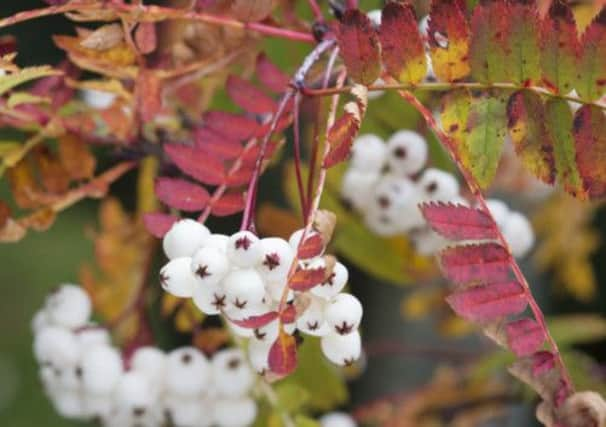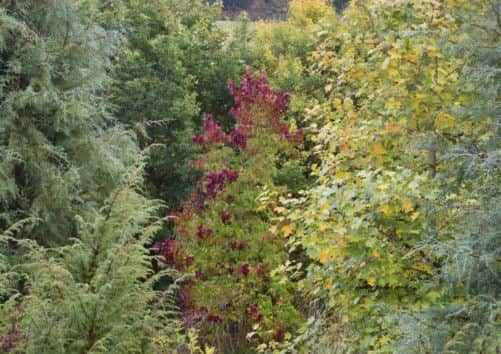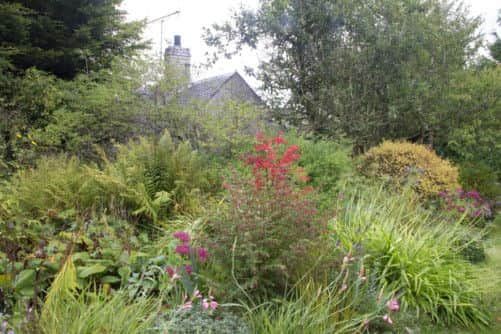Colour burst at a sloping Perthshire garden


When Fred and Mary Gardiner first bought their Victorian cottage, which is perched on the side of the Sidlaw Hills overlooking the Carse of Gowrie in Perthshire, the garden consisted of a small patch of surrounding land. For the next 25 years the couple gradually acquired more land until the sloping, south-facing site measured two acres.
Despite their initial inexperience, by the time they had the complete garden the couple had enough knowledge to establish a varied collection of trees and shrubs. Although this garden is packed with interest all year, it is perhaps in autumn that it is at its most dramatic. Now the lush greens of summer give way to a fiery palate of reds, yellows and gold, highlighted by berries.
Advertisement
Hide AdAdvertisement
Hide AdMary explains that the work of the late Geoffrey Dutton was a strong early influence. A biochemist, whose eight-acre ‘marginal’ garden north of Blairgowrie was composed of distinct eco-systems, Dutton possessed both the knowledge and the ability to plant on thin soil in extreme conditions following the natural contours of his steep plot. The result was a semi-wild garden planted within a backdrop of a range of native trees and shrubs with an emphasis on rhododendrons. The garden was especially spectacular in winter when covered in snow and ice.


Drawing on this inspiration, the Gardiners first focused on establishing a belt of trees that would later provide protection for more tender species. At 153m their garden was lower than Dutton’s, but exposed. Now Scot’s pine, wild cherry, larch, Field maple and Sea Buckthorn provide enough cover for an eclectic collection of trees that unfolds as you explore the grass paths that wind through the site.
Fred explains: “The paths are not always obvious, some are not firmly delineated. I find paths obtrusive.” Here the couple drew on Dutton’s advice, taking views and axes into consideration when laying out paths, thus incorporating the borrowed, surrounding landscape into the scheme.
“There are different levels in this garden, some are wilder than others,” Mary says, leading the way past the beds west of the house where a bright blue pool of agapanthus combines with yellow Inula hookeri; the latter is particularly attractive to butterflies. “I like gardening for wildlife, I enjoy berries on trees, rhododendron and herbs.” Tansy, she says, is particularly beneficial to insects. A favourite is the dwarf Sorbus, S. Reduca at 70cm and with deep pink berries the smallest tree in the garden strikes an autumnal note close to the house.
From here the path leads up the side of an open field and into the woodland area, where hedges were introduced for added shelter. When it came to placing hedges Fred again took advice from Dutton who suggested following the topology of the land “and then you won’t put a hedge in the wrong place.


“We have a lot of native species, including Hairy Birch, Betula pubescens,” says Fred. There is also B. utilis var.jacquemontii with its striking white bark and the Chinese red bark B. albosinensis var septentrionalis.
The variety of sorbus is like a treasure trove and similar to a child in a sweet shop you rush from one irresistible tree to the other. White berried sorbus, Fred points out, work well as the berries don’t get eaten as fast as the red and pink ones. Compact Sorbus koehneana, with its delicate, filigree foliage, is a case in point, but there are others, too numerous to mention.
Concentrating on the smaller varieties there is Sorbus Harry Smith, named for the Swedish botanist, also with white berries. Other favourites include pink-berried S. gonggashanica and white-fruited S. fructescens. Of the better-known varieties there was fast-growing pink changing to red-berried, S vilmorinii, S cashmeriana and pale-leaved S graeca.
Advertisement
Hide AdAdvertisement
Hide AdColour comes from a splendid Malus Sargentii covered in deep red berries, the scarlet foliage of Acer davidii, and the maroon foliage of its cousin Japanese maple, Acer palmatum Atropurpureum.
Scattered round the garden are varieties such as the Tulip tree and the fast-growing Nothofagus antartica. A Ginko biloba was grown from seed, as was the native North American Arbutus menziesii, the Handkerchief tree. The fine, yellow foliage of Cercidophyllum smells strongly of toffee apples in the morning.
When it comes to division of labour, Mary tends towards the weeding “but you can’t have a have a marginal garden and have it perfect,” while Fred does the planting, the pruning and placing the nesting boxes that are such a feature of this garden.
Birds, combined with other wildlife, add another dimension to this garden. Different varieties of butterflies, including Peacocks, Red Admiral and the Small Copper are to be found, and the families of Call ducks and bantams add to the rural feeling. The couple grow all their own fruit and herbs, and use wood from the garden, although always leaving some for wildlife. Mary says: “You go out there and there is always life around. Things are constantly changing; new things arrive as we establish new habitats and micro-climates.”
Some Branch Against the Sky, The Practice and Principals of Marginal Gardening by G J F Dutton is published by David & Charles